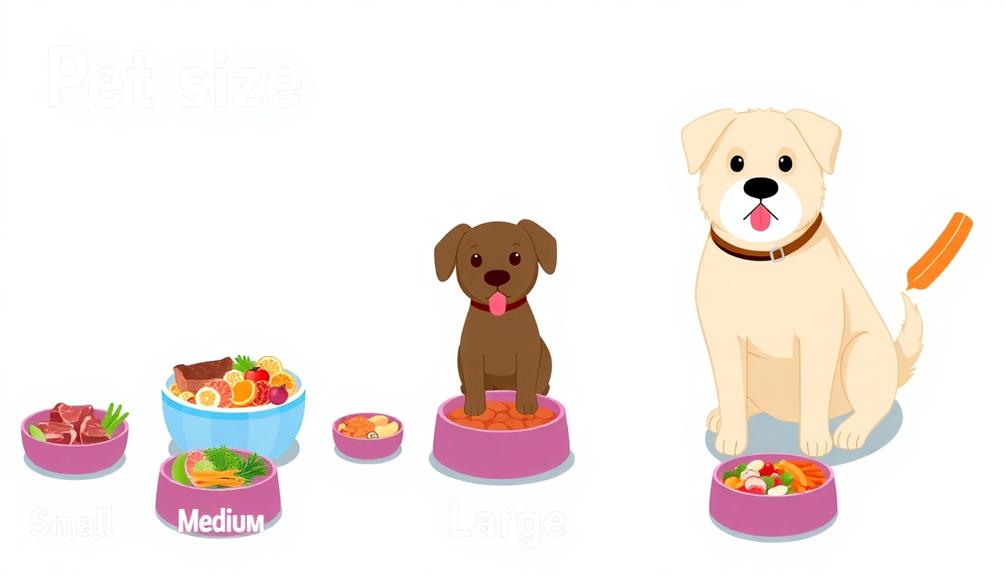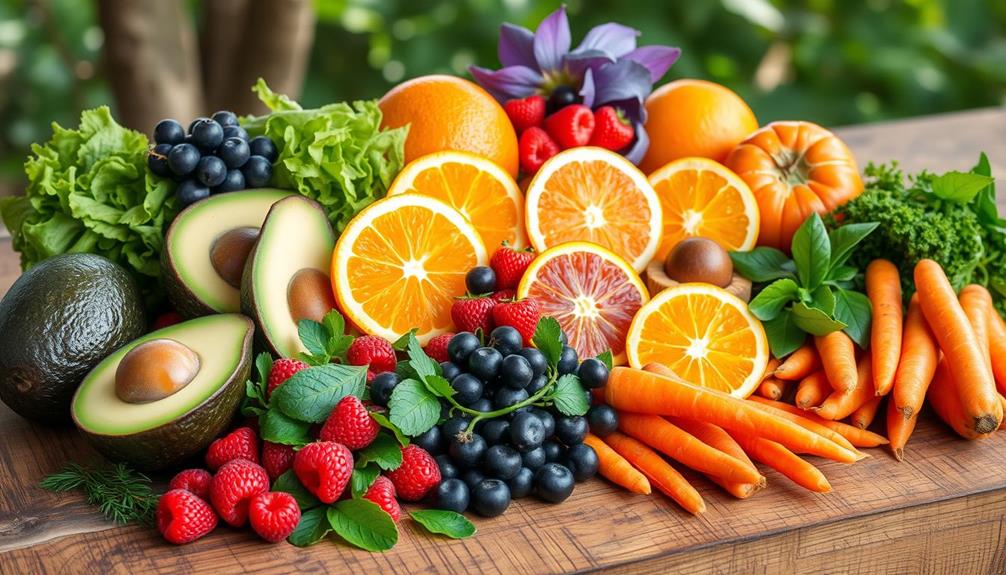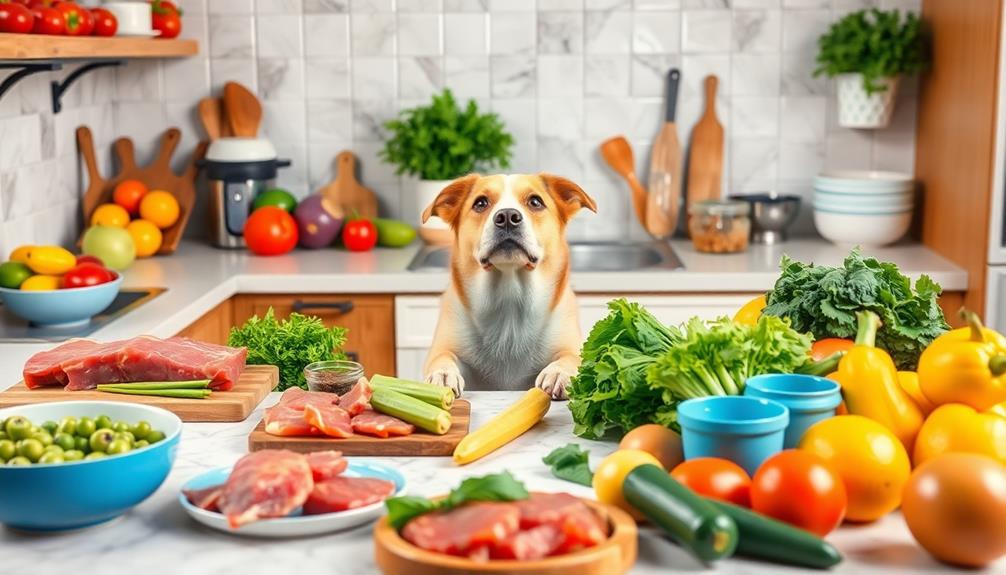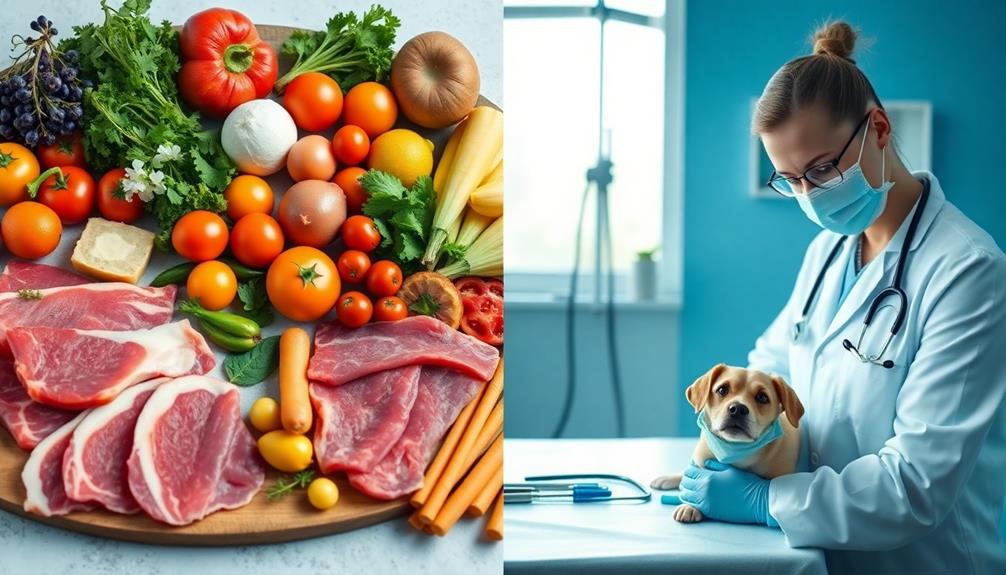Feeding your pet the right portions of raw food is key to their health. For dogs, aim for 2-3% of their ideal body weight daily; a 10 lb dog needs around 3.2 to 4.8 oz. Cats have similar needs, while ferrets require about 10% of their body weight. Puppies and kittens need more during growth—4-6% of their current weight. Regularly monitor their weight and activity levels to adjust portions as necessary. By understanding these guidelines, you'll guarantee your furry friend thrives. Keep going, and you'll discover even more tips to perfect their raw food diet.
Key Takeaways
- Determine your pet's type (dog, cat, or ferret) to find appropriate portion recommendations based on their size.
- For adult dogs and cats, feed 2-3% of their ideal body weight daily; adjust for smaller or larger breeds accordingly.
- Puppies and kittens require 4-6% of their current weight for growth; monitor their portion sizes as they develop.
- Adult ferrets need about 10% of their body weight daily, while kits require 20% for proper growth and health.
- Regularly monitor your pet's weight and adjust food portions based on their metabolism, activity levels, and health conditions.
Use These Charts
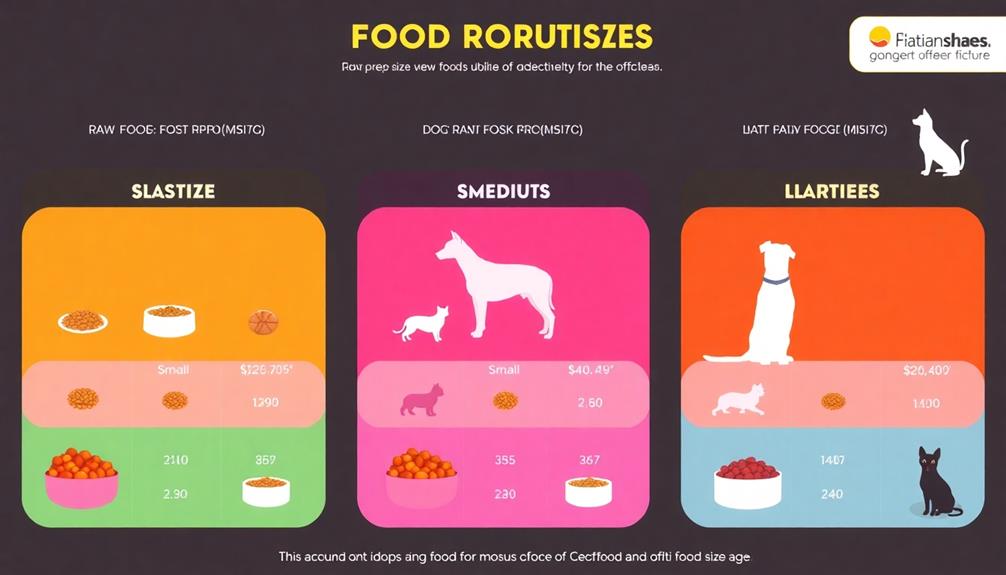
When it comes to feeding your pet, using the charts is essential for ensuring they get the right portions. Start by identifying your pet type, whether it's a dog, cat, or ferret.
Then, locate their weight on the left side of the chart to find the recommended daily feeding amounts. Keep in mind that feeding amounts vary considerably based on your dog's weight. Smaller dogs require smaller portions, while larger dogs need more raw food to meet their nutritional needs.
You should always refer to these charts for accurate portion control. They provide tailored feeding amounts for adult pets and guidelines for puppies, which typically need higher percentages of their body weight in raw food.
Regularly monitoring your dog's weight and overall health is critical, as you might need to adjust feeding amounts based on their individual metabolism and activity levels.
Feeding Raw Dog Food
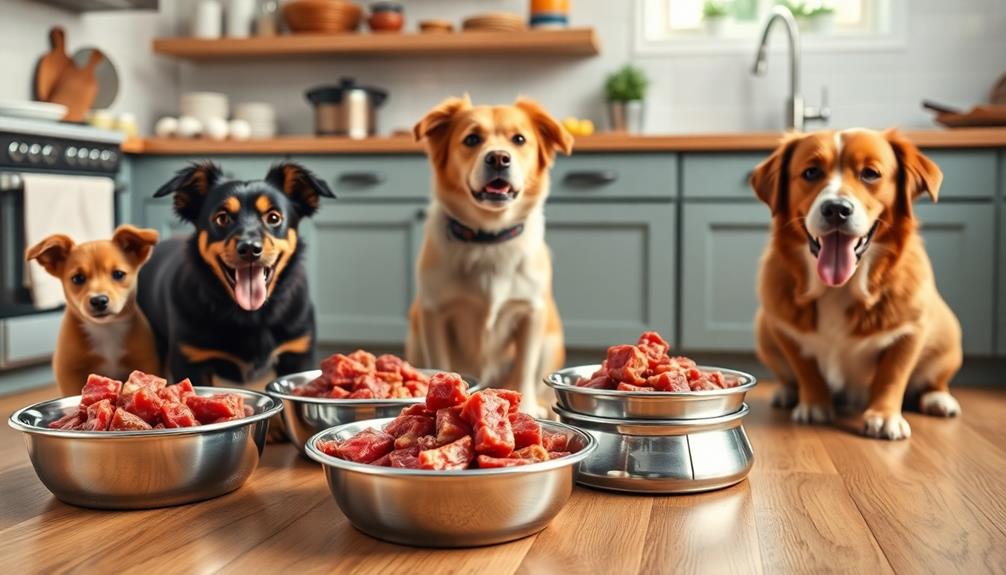
Feeding your dog a raw food diet can greatly impact their health and vigor. To guarantee your dog thrives on Raw Dog Food, it's vital to provide the right amount of food based on their size and life stage.
For adult dogs, aim to feed them 2-3% of their ideal body weight daily. For example, a 10 lb dog needs approximately 3.2 oz to 4.8 oz of raw food each day, depending on their activity level and metabolism.
Puppies, on the other hand, require 4-6% of their current weight daily for peak growth and development. Remember, adjusting the amount of food based on your dog's individual metabolism and activity level is fundamental for maintaining a healthy weight.
When starting with Raw Dog Food, it's best to changeover gradually. Begin with 25% raw food mixed with 75% of their old food, and slowly increase the raw portion over 13 days. This helps avoid digestive upset and allows your dog to adjust to their new diet smoothly.
Feeding Cats Raw Food
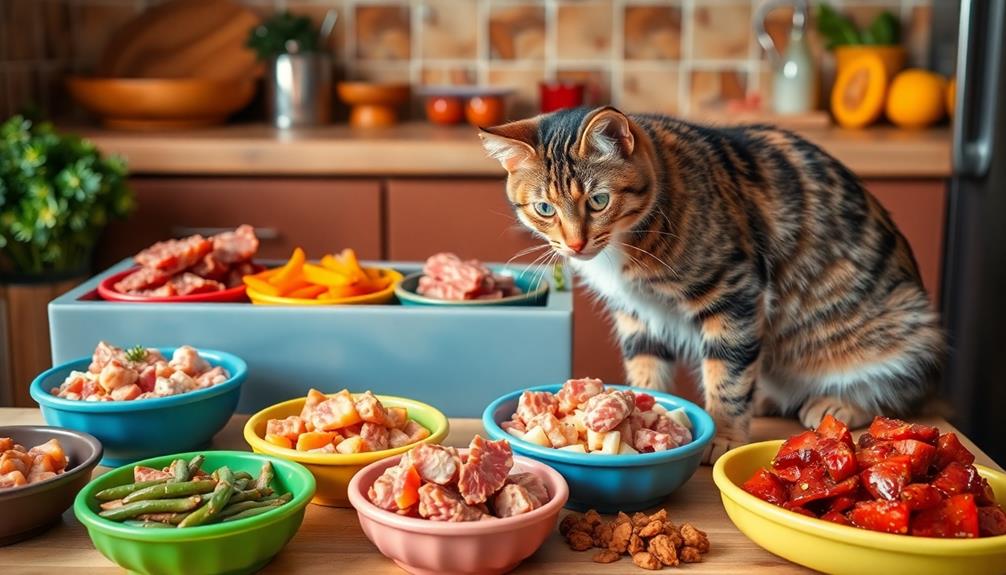
When feeding your cat raw food, aim for 2-3% of their ideal body weight each day for adults, while kittens need 4-6% for their growth.
You'll want to adjust these portions based on your cat's activity level and overall health.
Regularly check their body condition to guarantee they maintain a healthy weight, with ribs easily felt but without excess fat.
Ideal Portion Sizes
Finding the right portion size for your cat's raw food diet can be important for their health and well-being. Generally, adult cats should be fed about 2-3% of their ideal body weight each day. For instance, a 10 lb cat will need approximately 3.2 to 4.8 oz of raw food daily.
It's important to base this daily portion on your cat's specific needs, including their activity level and overall health.
Kittens, on the other hand, require more food to support their growth, typically consuming 4-6% of their current weight. For a 10 lb kitten, this means a daily feeding amount of 6.4 to 9.6 oz of raw food.
To determine the ideal portion size, use the formula: (cat's weight in lbs) x 0.02 to 0.03. This will give you a good estimate of how much food to provide, ensuring that your cat gets the nutrition they need without overfeeding.
Adjusting for Activity
Adjusting portion sizes based on your cat's activity level can greatly impact their overall health. Cats need a diet that reflects their energy needs. Generally, adult cats should be fed 2-3% of their ideal body weight daily.
Here's how to adjust for activity:
- Active Cats: If your cat is active and weighs 10 lbs, aim for 3.2 to 4.8 oz of raw food per day.
- Sedentary Cats: For more sedentary cats, stick to the lower end of the range to avoid excess weight gain.
- Kittens: They require more—about 4-6% of their current body weight daily, which means more frequent feedings.
- Monitoring: Keep an eye on your cat's body condition. If they're gaining or losing weight too quickly, adjust the amount of food accordingly.
Guidelines for Ferrets
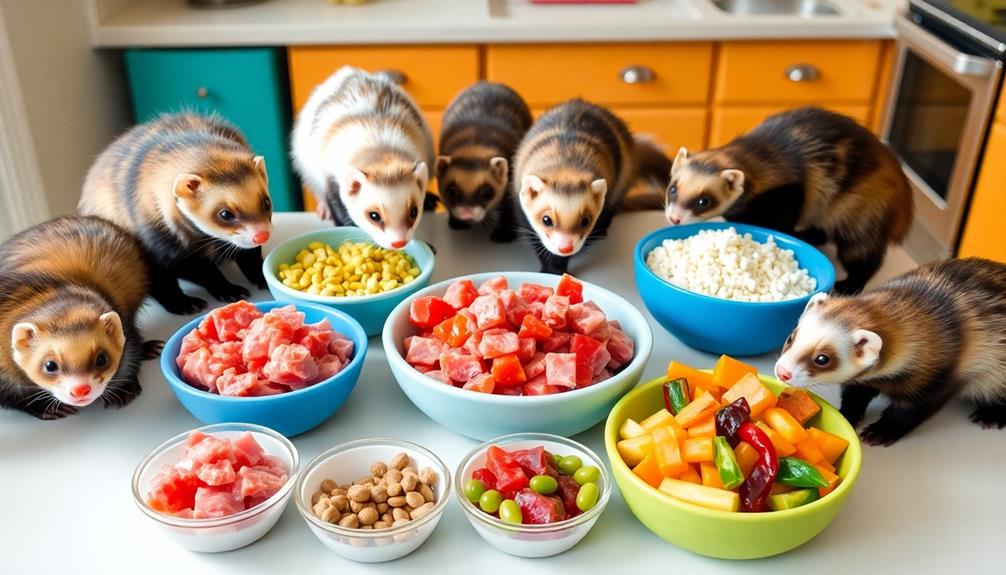
When it comes to feeding your ferret, you should aim for about 10% of their body weight daily for adults and 20% for kits.
Regularly monitoring their health and weight is key to making necessary dietary adjustments.
Daily Feeding Amounts
Understanding the daily feeding amounts for your ferret is essential for their health and well-being. Adult ferrets need about 10% of their body weight in food each day. For example, a 1 lb ferret requires roughly 1.6 oz of raw food daily.
Kits, or baby ferrets, have different needs and should be fed around 20% of their body weight to support their growth and development.
To guarantee your ferret thrives, follow these guidelines:
- Adult Ferrets: Feed approximately 10% of their body weight in raw food daily.
- Kits: Offer about 20% of their body weight in food each day.
- Monitor Weight: Regularly check your ferret's weight to adjust their feeding amounts according to their health and activity levels.
- Balanced Diet: Provide a variety of raw food that meets their unique nutritional requirements.
Monitoring Health Regularly
It's important to keep an eye on your ferret's health to guarantee they're thriving. Monitoring health regularly involves tracking their weight and observing any changes in behavior, appetite, or stool consistency.
Adult ferrets typically need about 10% of their body weight in food daily, while kits require around 20% to support their growth. For instance, a 1 lb ferret needs approximately 1.6 oz of food each day, but this can vary based on individual metabolism and activity levels.
Pay close attention to your ferret's stools. Loose stools can indicate dietary issues or health problems, so don't overlook these signs. Regularly check their weight, and if you notice any fluctuations, consult your veterinarian. They can help you determine if the food to feed needs adjustment or if there are other underlying health concerns.
Just like you give attention to your dogs, your ferret deserves the same level of care. Regular vet check-ups are vital to make sure your ferret is in good health and to refine their diet as needed.
Adjusting Based on Weight
Adjusting your ferret's food intake based on their weight is crucial for maintaining their health and energy levels. Adult ferrets should receive about 10% of their body weight in food daily, while kits need around 20% to support their rapid growth.
Here's how to tailor their diet effectively:
- Determine Current Weight: Weigh your ferret regularly to keep track of any changes.
- Calculate Daily Food: For a 1 LB ferret, provide approximately 1.6 oz of food each day.
- Monitor Activity Levels: Active ferrets may require more food, while less active ones may need less to prevent weight gain.
- Adjust as Needed: If your ferret shows signs of weight gain or loss, modify their intake accordingly.
Just like when you feed your dog, consistency is key.
Regularly reassess their needs based on their current weight, health, and metabolism.
Ideal Weight Assessment
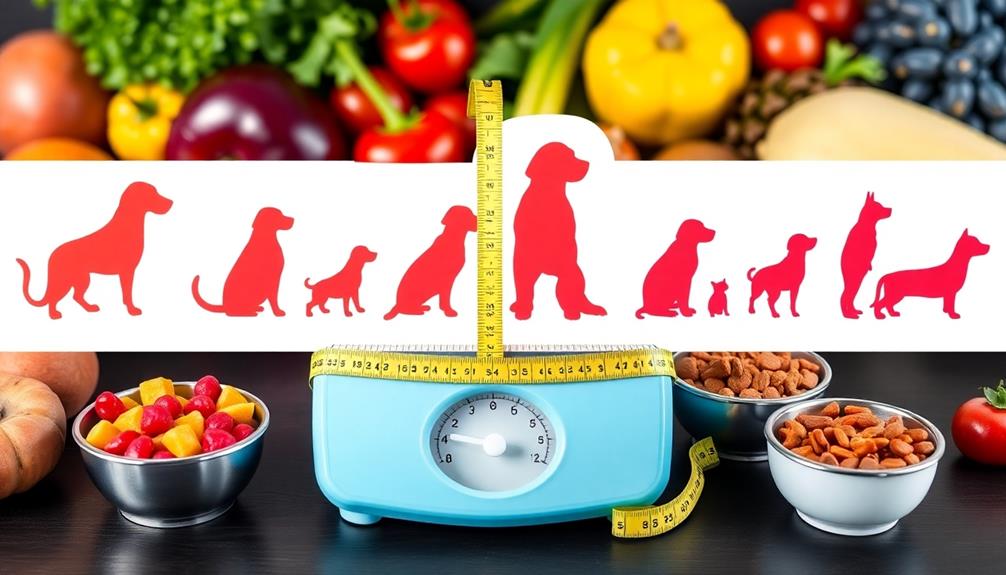
To assess your pet's ideal weight, focus on visual observation and tactile evaluation, which help you determine if your furry friend is at a healthy size.
Start by looking for a visible waistline when your pet stands. You should also be able to feel your dog's ribs without excess fat covering them.
If you see prominent ribs, your pet might be underweight and may need an increase in food for dogs to reach a healthier weight.
Conversely, if there's no visible waist and ribs are hard to feel, your pet is likely overweight and would benefit from a reduction in food intake.
Factors Influencing Dietary Needs

Understanding your dog's dietary needs goes beyond just counting calories; several key factors play an essential role in determining what and how much they should eat. Here are four critical influences to take into account:
- Activity Level: An active dog would require more calories than a sedentary one. Adjust their raw meat intake based on daily exercise.
- Metabolic Rate: Each dog has a unique metabolic rate. Monitor their energy levels and adjust food quantities per week to match their specific needs.
- Age: A dog's age considerably impacts its nutritional requirements. Puppies need different nutrients than adults, while senior dogs often require special considerations.
- Breed Characteristics: Different breeds may have distinct dietary preferences and requirements. Tailoring your dog's diet according to their breed can enhance their overall health.
Additionally, don't forget external factors like weather conditions. For example, colder temperatures might necessitate an increase in caloric intake to guarantee your dog stays warm and energetic.
Transitioning to Raw Diet

Shifting your pet to a raw diet can be an exciting journey, but it requires a careful approach to guarantee their health and comfort. Start by gradually introducing raw pet food, beginning with 25% raw and 75% of their old food for the first four days.
After that, increase the raw portion over the following week, aiming for a complete changeover to raw diet by day 13.
During this period, it's vital to monitor your pet's weight. Aim for a maximum weight loss of 1-2% per week to prevent excessive strain on their system. If your pet is a picky eater, consider extending each adjustment phase by a few days to help them adapt.
You may notice digestive changes, such as loose stools, as your pet adjusts. It's important to monitor stool consistency and adjust portions if they show signs of discomfort.
Always consult with a veterinarian for guidance, especially if you're changing diets for puppies or pregnant/nursing dogs, as they may need extra care during this process.
With patience and attention, your pet can thrive on their new diet!
Safe Handling and Storage

As you embrace the raw diet for your pet, safe handling and storage of raw food become important aspects of the process. Proper practices guarantee your pet stays healthy and safe while enjoying their meals. Here are some key tips to follow:
- Thaw Safely: Always thaw raw food gradually in the refrigerator. Don't leave it out at room temperature, as this can promote bacterial growth.
- Use Quickly: After thawing, use the raw food within 72 hours to maintain quality and safety.
- Prevent Cross-Contamination: Keep raw meat separate from other foods during storage and preparation. This helps avoid contamination and protects your family's health.
- Clean Thoroughly: After handling raw food, clean all surfaces and utensils to minimize the risk of foodborne illness. Discard any uneaten raw food after 30 minutes, and refrigerate leftovers for up to 24 hours.
Frequently Asked Questions
How Much Raw Food Should I Feed My Dog Chart?
To determine how much raw food to feed your dog, consider their weight, activity level, and metabolism. Generally, aim for 2-3% of their ideal body weight, adjusting as needed for peak health and digestion.
How Do You Calculate Raw Dog Food Portions?
Did you know that feeding your dog 2-3% of their ideal body weight daily can keep them healthy? To calculate portions, multiply their weight by 0.02 to 0.03 based on activity level, then divide into two meals.
What Is the 80-10-10 Rule for Raw Dog Food?
The 80-10-10 rule for raw dog food means you'll feed your dog 80% muscle meat, 10% bone, and 10% organ meat. This balance guarantees your dog gets essential nutrients for ideal health and vigor.
What Is the Best Raw Food Ratio for Dogs?
To find the best raw food ratio for dogs, you'll want to balance proteins, fats, and bones. Aim for about 80% meat, 10% organs, and 10% bones to guarantee a nutritious diet. Adjust as needed!
Conclusion
In summary, shifting your pet to a raw food diet can be rewarding, but it's crucial to understand their specific needs. Did you know that nearly 70% of pet owners report improved coat quality and energy levels after switching to raw? By using the portion guides and guidelines provided, you can guarantee your furry friend thrives on this nutritious diet. Remember, always prioritize safe handling and storage to keep their meals fresh and healthy!

